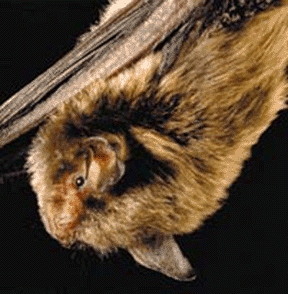How big does a Indiana bat get? Here is an overview over the average adult age:
A grown Indiana bat (Myotis sodalis) reaches an average size of 4.7 cm (0′ 2″).
When born, they have an average size of 0 cm (0′ 0″). During their lifetime of about 20 years, they grow from 4 grams (0.01 lbs) to 7 grams (0.02 lbs). Talking about reproduction, Indiana bats have 1 babies about 1 times per year. The Indiana bat (genus: Myotis) is a member of the family Vespertilionidae.
As a reference: Humans reach an average body size of 1.65m (5′ 5″) while carrying 62 kg (137 lbs). A human woman is pregnant for 280 days (40 weeks) and on average become 75 years old.

The Indiana bat (Myotis sodalis) is a medium-sized mouse-eared bat native to North America. It lives primarily in Southern and Midwestern U.S. states and is listed as an endangered species. The Indiana bat is gray, black, or chestnut in color and is 1.2–2.0 in long and weighs 4.5–9.5 g (0.16–0.34 oz). It is similar in appearance to the more common little brown bat, but is distinguished by its feet size, toe hair length, pink lips, and a keel on the calcar.Indiana bats live in hardwood and hardwood-pine forests. It is common in old-growth forest and in agricultural land, mainly in forest, crop fields, and grasslands. As an insectivore, the bat eats both terrestrial and aquatic flying insects, such as moths, beetles, mosquitoes, and midges.The Indiana bat is listed as an endangered species by the U.S. Fish and Wildlife Service. It has had serious population decline, estimated to be more than 50% over the past 10 years, based on direct observation and a decline on its extent of occurrence.
Animals of the same family as a Indiana bat
We found other animals of the Vespertilionidae family:
- Rüppell’s broad-nosed bat with 1 babies per litter
- Banana pipistrelle with 1 babies per litter
- Angulate pipistrelle with a weight of 3 grams
- Arizona myotis with a weight of 8 grams
- Rendall’s serotine with a weight of 6 grams
- Groove-toothed bat with a weight of 4 grams
- Japanese house bat with 2 babies per litter
- Chinese pipistrelle with a weight of 5 grams
- Bobrinski’s serotine with a weight of 7 grams
- Greater mouse-eared bat with a size of 7.2 cm (0′ 3″)
Animals with the same size as a Indiana bat
Not that size really matters, but it makes things comparable. So here are a couple of animals that are as big as Indiana bat:
- Least shrew tenrec with a size of 5.2 cm (0′ 3″)
- Common pipistrelle with a size of 3.9 cm (0′ 2″)
- Southern little yellow-eared bat with a size of 5.3 cm (0′ 3″)
- Pallas’s long-tongued bat with a size of 4.8 cm (0′ 2″)
- Grey long-eared bat with a size of 4.1 cm (0′ 2″)
- Rüppell’s pipistrelle with a size of 4.5 cm (0′ 2″)
- Orange leaf-nosed bat with a size of 4.9 cm (0′ 2″)
- Daubenton’s bat with a size of 4.4 cm (0′ 2″)
- Ornate shrew with a size of 4.9 cm (0′ 2″)
- Egyptian slit-faced bat with a size of 5.2 cm (0′ 3″)
Animals with the same litter size as a Indiana bat
Here is a list of animals that have the same number of babies per litter (1) as a Indiana bat:
- Melck’s house bat
- Shrew-faced squirrel
- Indian muntjac
- Ashy black titi
- Black-tailed hutia
- Merriam’s pocket gopher
- Davis’s round-eared bat
- Painted ringtail possum
- Black-mantled tamarin
- Little bent-wing bat
Animals with the same life expectancy as a Indiana bat
Completely different animals, but becoming as old as a Indiana bat:
- Six-banded armadillo with an average maximal age of 18.75 years
- Roe deer with an average maximal age of 17 years
- Nyala with an average maximal age of 16 years
- Northern elephant seal with an average maximal age of 20.25 years
- Sable antelope with an average maximal age of 22.25 years
- Dhole with an average maximal age of 16 years
- Black bearded saki with an average maximal age of 18 years
- Moustached guenon with an average maximal age of 23 years
- Dama gazelle with an average maximal age of 17.25 years
- Southern reedbuck with an average maximal age of 16.75 years
Animals with the same weight as a Indiana bat
As a comparison, here are some other animals that weight as much as the Myotis sodalis:
- Flores woolly bat bringing 6 grams to the scale
- Eisentraut’s pipistrelle bringing 6 grams to the scale
- Large-eared pied bat bringing 8 grams to the scale
- Smoky shrew bringing 7 grams to the scale
- Arcuate horseshoe bat bringing 8 grams to the scale
- Antillean ghost-faced bat bringing 8 grams to the scale
- Golden-tipped bat bringing 6 grams to the scale
- Antillean ghost-faced bat bringing 8 grams to the scale
- Argentine brown bat bringing 7 grams to the scale
- Diminutive serotine bringing 6 grams to the scale
